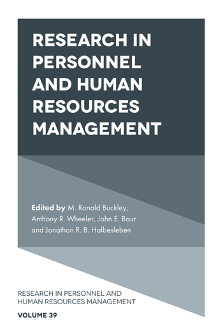
Index
Research in Personnel and Human Resources Management
ISBN: 978-1-80117-431-2, eISBN: 978-1-80117-430-5
ISSN: 0742-7301
Publication date: 19 August 2021
Citation
(2021), "Index", Buckley, M.R., Wheeler, A.R., Baur, J.E. and Halbesleben, J.R.B. (Ed.) Research in Personnel and Human Resources Management (Research in Personnel and Human Resources Management, Vol. 39), Emerald Publishing Limited, Leeds, pp. 289-299. https://doi.org/10.1108/S0742-730120210000039009
Publisher
:Emerald Publishing Limited
Copyright © 2021 M. Ronald Buckley, Anthony R. Wheeler, John E. Baur and Jonathon R. B. Halbesleben
INDEX
- Prelims
- 1: Human Resource Management and the Gig Economy: Challenges and Opportunities at the Intersection between Organizational HR Decision-Makers and Digital Labor Platforms
- 2: Explained Pay Disperson: A 20-Year Review of Human Resource Management Research and Beyond
- 3: “Going to Hell in a Handbasket?” Personnel Responses to Organizational Politics in Economically Challenged Environments
- 4: Coming of Age in a Global Pandemic: HRM Perspectives on Generation Z’s Workforce Entry
- 5: Network Structures of Influence within Organizations and Implications for HRM
- 6: Human Resource Management in Family Firms: Review, Integration, and Opportunities for Future Research
- 7: HRM Challenges for Immigrant Employees: Status-Laden Transitions Across Cultures and Workplace Social Environments
- 8: Multidimensional (Mis)Fit: A Systemic View of the Refugee Employment Journey from an HRM Perspective
- Index